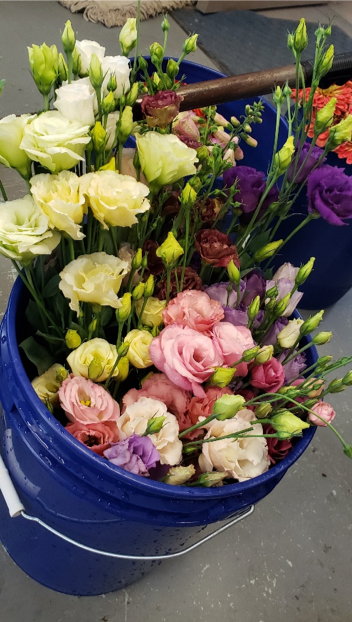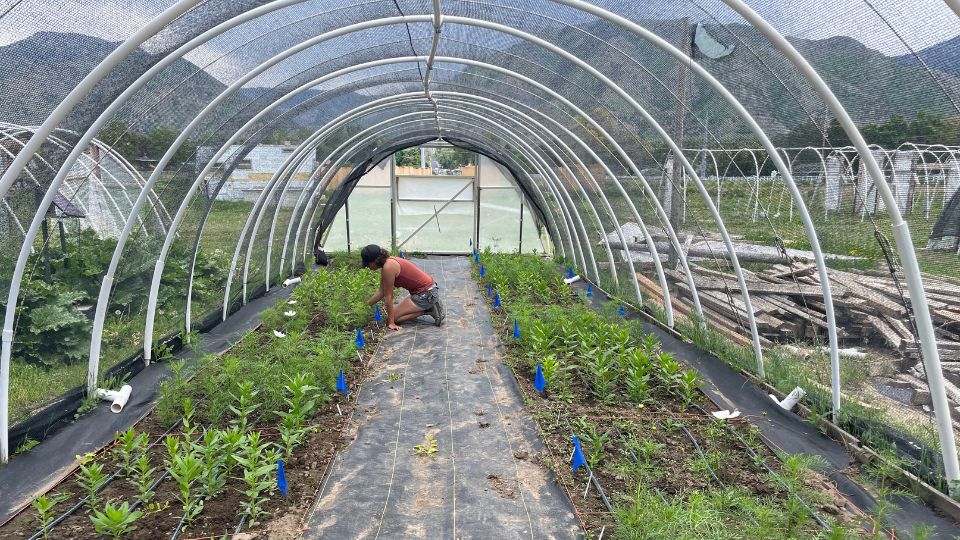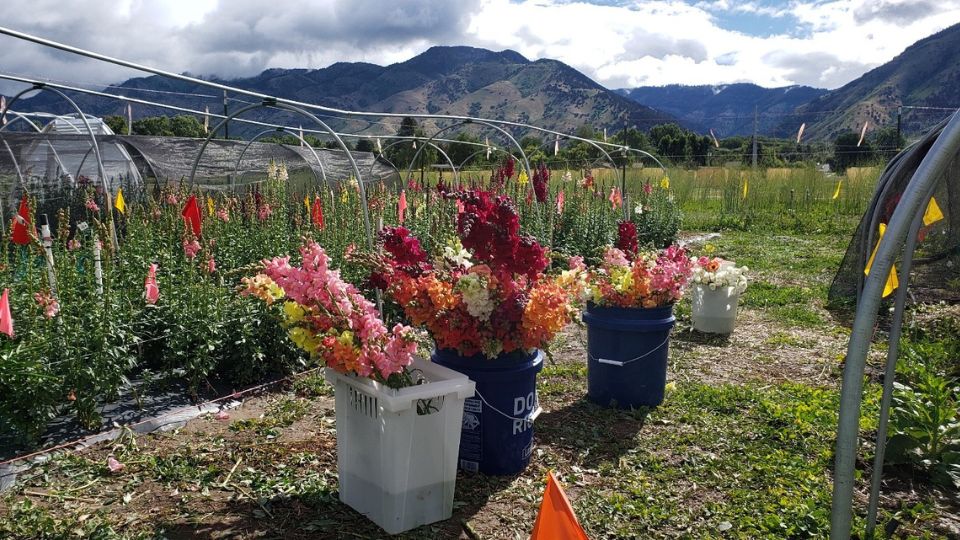Cut Flower Markets and Marketing in the Intermountain West

Introduction
Cut flowers may be sold in large quantities to wholesale distributors or florists, or they may be sold directly to consumers through farmers markets, community-supported agriculture (CSA) programs or subscription services, or “U-pick” operations (Columbia & Stock, 2021; Curtis & Stock, 2023; Ford et al., 2012). Direct-to-consumer markets for cut flowers allow for greater flexibility for growers but may be unable to accommodate large amounts of flowers (Columbia & Stock, 2021). Additionally, direct-to-consumer markets require growers to have skills in marketing, business management, and farming (Anderson, 2021). In contrast, selling cut flowers in bulk to wholesalers allows growers to focus more on growing their flowers (Ford et al., 2012). However, wholesalers typically purchase flowers from growers for lower prices than those seen at farmers markets or other direct-to-consumer markets (Ford et al., 2012).
Many growers begin by growing a mix of flowers that allows them to provide more variety when selling directly to consumers at farmers markets or similar venues but may prohibit production of large quantities that wholesale or florists may require (Columbia & Stock, 2021; Curtis & Stock, 2023). As cut flower growers gain experience and expand operations, they may move into wholesaler markets (Curtis & Stock, 2023). Understanding the strengths and limitations of each market allows growers to determine which markets best meet their operation’s needs and goals.
Wholesale Markets

The Society of American Florists (SAF) estimates that there are 12,154 retail florist shops and approximately 500 wholesale cut flower distributors (SAF, 2022). Many wholesale distributors have locations throughout the country, including the Intermountain West. Wholesalers tend to buy and sell flowers for prices that fluctuate based on market demand throughout the season and regional, national, and international product availability (Ford et al., 2012). Wholesale buyers purchase flowers in bunches or single stems, depending on the cost or value of the flower variety. Recent surveys conducted with florists indicate that they are interested in and willing to purchase locally grown flowers, but they have high standards for quality, service, and selection (Curtis & Stock, 2023; Ford et al., 2012). Most growers who sell to wholesale distributors or florists have been in the industry longer and developed established relationships and detailed quality standards (Curtis & Stock, 2023).
A directory of florists across five Intermountain West states compiled by Utah State University (USU) Extension found more than 1,300 florists, including retail florists and those focused on events such as weddings only. A 2022 survey of Utah florists found that 25% of florists in Utah would like to source most of their flowers from local growers and another 54% of florists would like to source at least some of their flowers locally (Curtis & Stock, 2023). However, most were unwilling to pay more than 10% more for locally sourced products. One obstacle for florists interested in sourcing from local growers is their variable needs regarding flower varieties, often a result of large events requiring specific varieties or colors (Columbia & Stock, 2021).
The large number of florists in the Intermountain West, their observed interest in sourcing locally grown flowers, and their increasing awareness of the selection and quality of Utah flowers indicates a potentially strong and expanding market for local flowers. Growers looking to sell their flowers to florists can benefit from contacting florists in their area who may be interested in buying locally. Often, florists with artistic styles will be more interested in working with different flower varieties than those who work with larger companies and have set design offerings (Gormandy, 2023). Providing product pictures and samples to florists at first contact may positively impact sales, as will maintaining open communication about product availability and any issues that may impact availability, such as pests and weather events (Gormandy, 2023).
In addition to wholesalers, cooperatives provide an outlet for growers to sell flowers in larger quantities. In Utah, there are at least three cut flower cooperatives. These cooperatives typically operate between April and October, serving growers and florists in the state. They sell directly to florists and charge cooperating farms a fee between 30%–40% of sales. Online cooperative-style vendors are also gaining momentum. GatherFlora is one example, offering region-specific access to locally sourced flowers for their florist customers (GatherFlora, 2023). They currently operate in several western and southeastern states.
Direct-to-Consumer Markets
As wholesale and florist markets often require larger quantities with standardized quality grades, smaller-scale flower growers may find direct-to-consumer markets a better fit (Gormandy, 2023; Scoggins, 2019). Direct-to-consumer sales also typically generate higher profit margins for growers and allow for greater inventory flexibility (Columbia & Stock, 2021; Ford et al., 2012; Horwitz & Hashley, 2008; Scoggins, 2019). By connecting with customers, direct market growers can develop a niche by providing the freshest, highest-quality blooms (Ford et al., 2012) and increasing outreach on the benefits and availability of local flowers.
Farmers Markets
The number of farmers markets have increased over the last two decades in response to a growing consumer interest in fresh, local food and other local products (Murphy & Hyde, 2022; Pilar et al., 2019). Consumers are also increasingly interested in the quality and composition of their food (Pilar et al., 2019). Farmers markets provide a key link in agriculture by acting as a short supply chain that fits well with farmers and growers that may not be able to compete in conventional markets while also providing consumers with an opportunity to shop in ways that suits their values for ethical, responsible, and environmentally friendly products that support their local community’s economy (Murphy & Hyde, 2022; Pilar et al., 2019). The U.S. Department of Agriculture (USDA) defines farmers markets as “a common area where several farmers gather on a recurring basis to sell a variety of fresh fruits, vegetables, and other farm products directly to consumers” (Economic Research Service [ERS], 2014).
Fresh produce is the most common item sold at farmers markets, but beyond available products, the experience and ambience of farmers markets is a significant draw for customers (Murphy & Hyde, 2022; Pilar et al., 2019). Farmers markets allow consumers to interact face-to-face with growers and obtain information about products in a social setting they cannot find at supermarkets (Murphy & Hyde, 2022; Pilar et al. 2019). These consumers are looking for fresh products and are interested in reducing food and flower miles and carbon footprints while supporting local growers (Pilar et al., 2019).
For local growers interested in selling cut flowers, farmers markets can provide direct contact with many customers in one location, low start-up costs, and immediate cash payment for goods sold (Horwitz & Hashley, 2008). Additionally, farmers markets often advertise themselves in the community, reducing advertising costs for growers who sell at the markets. However, farmers markets require a large amount of labor to prepare and run a booth or stall, there is limited access to coolers or water to keep flowers from wilting, and there can be competition from other growers (Hays, 2022; Horwitz & Hashley, 2008). Farmers markets require growers to have customer service and sales skills. Inclement weather can also impact customer turnout and sales (Hays, 2022).

Cut flower growers considering selling their products at farmers markets should first determine if the market is a good fit for their business (Horwitz & Hashley, 2008). Market managers can answer questions about fees and policies, but growers should also determine if their target customers frequent the market or if other venues would better meet their needs. Cut flowers in bouquets, bunches, or single stems are naturally appealing and can create a gorgeous display to attract customers at a farmers market (Hays, 2022). Effective displays are neat, clean, and feature the farm or business’s name and logo as well as clearly visible pricing information (Hays, 2008; Horwitz & Hashley, 2022; Murphy & Hyde, 2022). Displaying products at varied heights and arranging different colors and textures can also increase the booth’s visual appeal for customers while highlighting specific products (Horwitz & Hashley, 2008; Murphy & Hyde, 2022).
When setting prices for goods at market, growers should consider their costs, including labor, fees set by the market organizers, and any needed items such as coolers, tables, tents, and signage used to set up their booths (Ford et al., 2012; Horwitz & Hashley, 2008). Generally, prices at farmers markets in urban areas are higher than prices seen at markets in rural areas (Ford et al., 2012).
Community-Supported Agriculture and Subscription Services
Until recently, CSAs and local produce subscription services have not been well advertised, though social media has enabled growers to market themselves effectively and economically as they reach interested customers (Columbia & Stock, 2021). This also enables growers to be more connected with their established consumer base, though they may be unable to achieve the same amount of face time seen at farmers markets (Columbia & Stock, 2021). Most CSA programs are based around fresh produce, so flower growers may be able to partner with other local farmers and offer their flowers as an optional add-on to an existing CSA program (Ford et al., 2012). In addition to marketing subscription options to individuals and households, growers may reach out to restaurants, hospitals, offices, country clubs, and other businesses to provide a weekly arrangement of fresh local flowers (Columbia & Stock, 2021).
U-Pick Operations

U-pick operations offer a unique option for cut flower growers who are not interested in farmers markets, CSAs, or subscription services to market their flowers. U-pick operations require less time and labor in harvesting and preparing products than farmers markets or CSAs but can involve other risks and challenges (Miller et al., 2021). Customers can unintentionally cause damage by trampling plants or entering areas marked “off limits” (Miller et al., 2021). Growers offering U-pick experiences to customers should consider liability insurance to cover potential customer injuries from tripping on hoses or nicks if shears are used to pick flowers (Miller et al., 2021). Adequate signage and training can prevent injuries and damage to crops or tools. Planting fewer flowers to increase space for pathways can also reduce damage and injuries. U-pick operations can add to their offerings and increase value to customers by providing vases, ribbons, cards, or drying kits to accompany flowers (Miller et al., 2021).
Farm Venues
Another method to turn cut flowers into a profitable enterprise is offering agritourism experiences such as sunflower mazes or classes in flower arranging (Knoch, 2022; Miller et al., 2021). Cut flower growers may also decide to go into floristry as farmer-florists and sell their own arranged bouquets (Knoch, 2022). They may offer a field of flowers as a scenic venue for photographers to use for graduation, engagement, wedding, or family portraits and charge by the hour or offer fresh flowers as props or staged backdrops for photographers (Miller et al., 2021). Selling plant stock and botanical dyes can also provide income streams for cut flower growers (Knoch, 2022).
Online Options
Finally, with recent increases in the prevalence of online shopping, especially following the COVID-19 pandemic, many cut flower operations have added online components to their business (PR Newswire, 2022). Though they provide less face time with customers, websites and social media can provide additional avenues to connect with consumers and remove potential obstacles.
Marketing and Consumer Education
In 2016, the American Floral Endowment released a report detailing strategies that may be effective in reaching potential customers and suggested that cut flower growers and retailers would benefit from using creative marketing strategies (Yue et al., 2016). Improved atmosphere in the home and positive experiences with flowers have both been suggested as potential marketing points for cut flowers (Kelleher, 2018; Oppenheim, 1996). Since 2010, social media has presented promising options for marketing cut flowers (Anderson, 2021; Columbia & Stock, 2021). Because of their aesthetic appeal, photogenic flowers are naturally suited to social media marketing (Anderson, 2021; Columbia & Stock, 2021). Using Instagram and other social media outlets and partnering with influencers can potentially increase interest in flowers among millennials and younger consumers who are purchasing fewer flowers (Irani et al., 2011; Kelleher, 2018).
Social Media
The dynamic and volatile nature of social media requires businesses to know where to find their consumers. In 2016, researchers at the American Floral Endowment found that millennials over age 26 were more likely to be on Facebook, while those under 26 years old were more likely to be on Instagram or Snapchat; YouTube was a favorite site for both groups (Yue et al., 2016). TikTok, one of the most popular social media platforms in 2023, hadn’t been launched when they released their report, indicating the need for flexibility and adaptability in social media marketing campaigns. Consumers on social media were found to prefer active accounts with up-to-date information and high-quality photos and visuals (Yue et al., 2016). Additionally, consumers liked a variety of content beyond just advertisements and appreciated quick responses from businesses to their comments, messages, and reviews (Yue et al., 2016).
Effective strategies for Instagram marketing include regular posts with focused content and captions with a genuine, personal voice and appropriate hashtags to make content more easily searchable (Stock, 2020). Though optimal posting frequency is debated, it has been found that consistency and reliability are important to establishing reach and engagement on social media, and social media leaders average three posts each week and focus on post quality over quantity (Stock, 2020).
Beyond just advertising and marketing, social media can provide consumers with education and information with the potential to improve sales (Columbia & Stock, 2021). Younger consumers typically aren’t as knowledgeable about flower arranging or flower care and may be intimidated by the idea of purchasing something they don’t know how to care for (Kelleher, 2018). Consumers can benefit from information on how long their flowers will last and how to care for specific flower varieties (Li et al., 2016; Rihn et al., 2011). For growers selling through a CSA or subscription service, it may be helpful to educate consumers on why products may not be available or why they are priced the way they are, such as including explanations of pest or weather impacts on crops (Columbia & Stock, 2021).
Conclusion
The wide variety of available markets makes it possible for cut flower growers to select one or more markets best suited to their needs. Direct-to-consumer markets require a range of skills for growers to be successful but also allow for much greater flexibility and smaller quantities than often needed by wholesalers or florists (Anderson, 2021). Whichever method of direct-to-consumer sales growers use, they will have direct contact with their customers, thus developing relationships and growing a strong customer base (Horwitz & Hashley, 2008).
Though wholesalers and florists may not be as flexible, they can provide an outlet for bulk floral sales beyond what can typically be accommodated through farmers markets or CSA programs (Ford et al., 2012). For large-scale cut flower farms, the ease and relative convenience of selling product to a wholesaler may outweigh the lower prices wholesalers pay (Ford et al., 2012). By evaluating the strengths and limitations of each market, cut flower growers can determine markets or a combination of markets most effective at helping them reach their operation’s goals.
References
-
Anderson, L. (2021). From plot to vase: farming flowers. The Horticulturist, 30(2),12–15.
-
Columbia, S. L. & Stock, M. (2021). Cut flowers for community supported agriculture production [Fact sheet]. University of Kentucky Extension. https://www.uky.edu/ccd/marketready/CutFlowerCSA
-
Curtis, K. R., & Stock, M. (2023). Research report: Growing a new cut flower industry: Market needs and preferences. Journal of Food Distribution Research, 54(1), 1–7.
-
Curtis, K. R., & Stock, M. (2023) Utah florist preferences for local cut flowers [Fact sheet]. Utah State University Extension. https://extension.usu.edu/apec/research/florist-preferences-for-local-cut-flowers
-
Economic Research Service (ERS). (2014, August 4). Number of U.S. farmers’ markets continues to rise. U.S. Department of Agriculture. https://www.ers.usda.gov/data-products/chart-gallery/gallery/chart-detail/?chartId=77600
-
Ford, T., Kime, L., Harper, J. K., & Bogash, S. (2012, December 17). Cut flower production. Penn State Extension. https://extension.psu.edu/cut-flower-production
-
GatherFlora. (2023). Local flower sourcing simplified. Retrieved June 10, 2023, from https://www.gatherflora.com/home.
-
Gormandy, K. (2023, January 27). Selling flowers wholesale: How to sell direct to florists [Web log post]. Team Flower. https://education.teamflower.org/learn/growing/selling-farm-flowers-wholesale-to-florists
-
Hays, S. (2022, February 10). A new grower’s guide to selling flowers at a farmers’ market [Web log post]. Team Flower. https://education.teamflower.org/learn/growing/ssl/a-new-growers-guide-to-selling-flowers-at-a-farmers-market
-
Horwitz, S., & Hashley, J. (2008, May). Plain language guide to selling at a farmers market. New Entry Sustainable Farming Project.
-
Irani, T. A., Clark, D., Raulerson, B., & Slough, D. (2011). Not your grandmother’s flowers: What combination of flower fragrance and color is preferred by young adult consumers? American Floral Endowment.
-
Kelleher, K. (2018, October 2). Can Instagram save the flower industry? Observer. https://observer.com/2018/10/can-instagram-save-the-flower-industry/
-
Knoch, J. (2022). BLOOM BOOM: We’re putting more thought into where our food comes from, but what about our blooms? Look inside the gorgeous, growing, female-led slow flowers revolution. Chatelaine, 95(5), 32–38.
-
Li, Z., McCracken, V., & Connolly, J. (2016, July 31–August 2). An evaluation of factors influencing consumer purchase decisions of cut flowers, a study of Washington consumers [Paper presentation]. Agricultural and Applied Economics Association Conference, Boston, MA, United States. https://ageconsearch.umn.edu/record/235227/?ln=en
-
Miller, A., Ford, T., & Kime, L. (2021, January 5). Sunflower u-pick. Penn State Extension. https://extension.psu.edu/sunflower-u-pick
-
Murphy, E., & Hyde, J. (2022, December 15). Standing out at a farmers’ market. Penn State Extension. https://extension.psu.edu/standing-out-at-a-farmers-market
-
Oppenheim, P. P. (1996). Understanding the factors influencing consumer choice of cut flowers: A means-end approach. Acta Horticulturae, 429, 415–422. https://doi.org/10.17660/actahortic.1996.429.52
-
Pilař, L., Kvasničková Stanislavská, L., Moulis, P., Kvasnička, R., Rojík, S., & Tichá, I. (2019). Who spends the most money at farmers’ markets? Agricultural Economics (Zemědělská Ekonomika), 65(11), 491–498. https://doi.org/10.17221/69/2019-agricecon
-
PR Newswire. (2022, April 28). United States cut flowers market forecast report 2021–2028: Marketing strategies adopted by the market players & increase in demand for cut flowers for decorative purposes. Cision. https://www.prnewswire.com/news-releases/united-states-cut-flowers-market-forecast-report-2021-2028-marketing-strategies-adopted-by-the-market-players--increase-in-demand-for-cut-flowers-for-decorative-purposes-301535232.html
-
Rihn, A. L., Yue, C., Behe, B., & Hall, C. (2011). Generations X and y attitudes toward fresh flowers as gifts: Implications for the floral industry. HortScience, 46(5), 736–743. https://doi.org/10.21273/hortsci.46.5.736
-
Scoggins, H. (2019, March 6). Marketing Specialty Cut Flowers. Community, Local & Regional Food Systems. https://foodsystems.extension.org/marketing-specialty-cut-flowers/
-
Society of American Florists (SAF). (2022, December 14). Floral industry facts. safnow.org. https://safnow.org/trends-statistics/floral-industry-facts/
-
Stock, M. (2020, December). High impact extension programming with Instagram. HortTechnology, 30(6), 654–658. https://doi.org/10.21273/horttech04693-20
-
Yue, C., Zhao, S., & Rihn, A. (2016). (rep.). Marketing tactics to increase millennial floral purchases. American Floral Endowment.
Published December 2023
Utah State University Extension
Peer-Reviewed Fact Sheet
Authors
Makaylie Langford, USU Extension Intern, Department of Applied Economics;
Kynda Curtis, Professor & USU Extension Specialist, Department of Applied Economics;
Melanie Stock, Assistant Professor & USU Extension Specialist, Department of Plants, Soils, and Climate
Related Research






